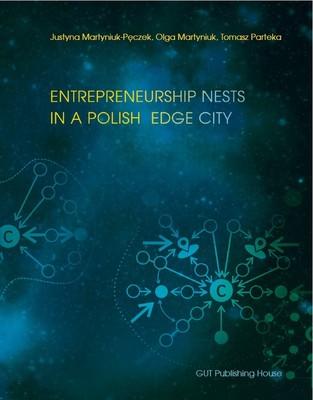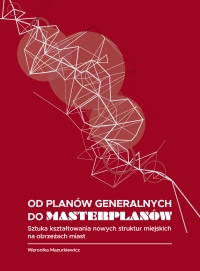Opis
Entrepreneurship Nests in a Polish Edge City
autorzy: Martyniuk Olga, Martyniuk-Pęczek Justyna, Parteka Tomasz
Wydawnictwo Politechniki Gdańskiej
The last two decades in Poland have been a period of both a dynamic development of the small and medium- sized enterprise sector and a transformation of the city surrounding zones. This development began during the economy transformation after 1989. Population migration and movement of economic entities away from central cities resulted in development of territorial structures within some Polish suburban areas, defined as entrepreneurship nests. This may mean that economic activity of these inhabitants may be higher than that of the central-city residents. What is more, it seems to be a distinguishing feature of the Polish suburban areas, compared to the suburbanization areas of other Western European countries or the United States.
The topic of the relationship between suburbanization processes and the development of small and medium-sized enterprise (SME) sector derives from the Authors’ work on a scientific project entitled Creation of entrepreneurship nests in the Tri-City Metropolitan Area. Analysis of the spatial and economic relations of the SME sector, financed by the National Science Center (contract number UMO-2013/09/B/HS4/01175).
The scientific aim of the project was to determine the impact of the local SMEs’ development on the suburbanization processes in selected suburban areas, on the example of the Tri-City Metropolitan Area (TMA2). The study on the relationship between the level NCN [original in PL: Narodowe Centrum Nauki] is a government agency, supervised by the Ministry of Science and Higher Education, set up in 2011 to support basic research in Poland. Tri-City Metropolitan Area consists of three cities in Pomerania, Poland: Gdańsk, Gdynia and Sopot, including minor towns in their vicinity. of SMEs’ economic activity and the suburbanization processes, on the example of the TMA, can be described as continuation and deepening of earlier research in the field of urban planning [Lorens 2005], sociology [Kajdanek 2012], economic geography [Beim 2009] and regional development, with regard to the process of suburbanization.
The innovative nature of the study lies in the attempt to answer the question of how SME-sector entities affect the form of metropolis functioning, resulting in a model of a Polish edge city, propounded by the Authors, which is based on development of entrepreneurship nests.
TABLE OF CONTENTS
Introduction 5
1. The essence of contemporary suburbanization . . 13
1.1. The concept of suburbanization . . . . . . . . . . 13
1.2. Evolution of the American suburbanization . . . 14
1.3. Spatial models of American suburbanization . . 23
1.4. Global spatial models of contemporary
metropolitan area development . . . . . . . . . . 26
2. Spatial models of suburbanization in Poland . . . 29
2.1. Defining the concept of suburbanization
in the Polish research area . . . . . . . . . . . . . 29
2.2. Suburbanization processes in Poland . . . . . . . 31
2.3. The concept of spatial models
of suburbanization in Poland . . . . . . . . . . . 38
3. Characteristics and development of the SME
sector in Poland . . . . . . . . . . . . . . . . . . . . 41
3.1. The concept and classification of SME-sector
enterprises . . . . . . . . . . . . . . . . . . . . . . 41
3.2. Characteristic features of SMEs . . . . . . . . . . 44
3.3. Significance of the SME sector
for socio-economic development in Poland . . . 47
3.4. Development of the SME sector in Poland
in the years 1980–2014 . . . . . . . . . . . . . . . 49
4. The Polish SME sector in national and
metropolitan configuration . . . . . . . . . . . . . 55
4.1. Causes of entrepreneurship in Poland
and in the world . . . . . . . . . . . . . . . . . . 55
4.2. The SME sector in the Pomeranian
Voivodeship against the background
of Poland . . . . . . . . . . . . . . . . . . . . . . 58
4.3. The SME sector in central cities
of the Tri-City Metropolitan Area (TMA) . . . . 60
4.4. The SME sector’s development
on the example of the TMA . . . . . . . . . . . . 63
5. Spatial models of entrepreneurship nests
in the TMA . . . . . . . . . . . . . . . . . . . . . . . 71
5.1. The SME sector in entrepreneurship nests . . . . 71
5.2. Analysis of the spatial structure
of entrepreneurship nests . . . . . . . . . . . . . 76
5.3. Micro-scale features of urbanarchitecture
structure on the example
of entrepreneurship nests . . . . . . . . . . . . . 88
5.4. Spatial models of SME activity
in entrepreneurship nests . . . . . . . . . . . . . 94
5.5. Models of territorial SME development
in entrepreneurship nests . . . . . . . . . . . . . 95
6. Determinants of SME localization
in entrepreneurship nests and suburban zones . . 99
6.1. Classification and characteristics
of enterprise localization determinants . . . . . 99
6.2. Analysis of SME-localization determinants
in selected TMA municipalities
and entrepreneurship nests . . . . . . . . . . . 101
6.3. Assessment of SME localization
attractiveness in the suburban areas
of the TMA . . . . . . . . . . . . . . . . . . . . 104
6.4. Taxation policy in the municipalities
examined vs economic activity of SMEs . . . . 106
6.5. Location risk in decisional localizations
of SMEs . . . . . . . . . . . . . . . . . . . . . . 108
7. The edge city perspective based on Polish
entrepreneurship nests . . . . . . . . . . . . . . . . 113
References . . . . . . . . . . . . . . . . . . . . . . . . . 119











Opinie
Na razie nie ma opinii o produkcie.